Music and Movements
Cry You One at the International Festival of Arts & Ideas
Cry You One covers a lot of terrain. Over the course of three hours, audience members traverse more than a mile through the verdant forests of Connecticut’s Maltby Lakes. Before the show, an Arts & Ideas Festival staff member (the New Haven-based festival is presenting the production) warns participants about possible hazards, including uneven ground, ticks, and snakes. But the risks presented by these woods pales in comparison to the dangers that threaten the landscape of coastal Louisiana, the inspiration for and subject of Cry You One, created by New Orleans-based companies Mondo Bizarro and ArtSpot Productions.
Using only their bodies and some basic props to demonstrate, the company surveys the damage. For decades, the oil and gas industry’s ecological-terrorism has devastated Louisiana’s wetlands. Manmade change to the Mississippi delta, including levees and industrial pollution, have caused high rates of cancer and land erosion that wreak havoc on people who aren’t able to leave their sinking neighborhoods. Add centuries-old currents of racism to this trajectory, and the situation feels hopeless.
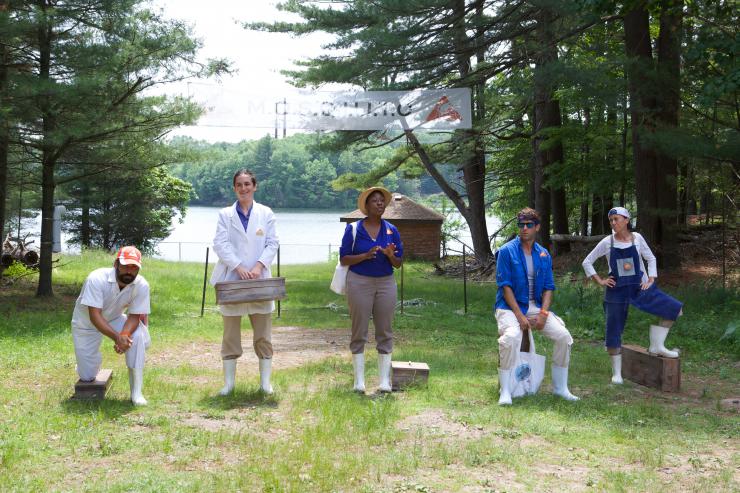
Yet hope abounds in Cry You One. Like a New Orleans jazz funeral, the production syncopates sorrow and joy. It praises as it mourns. While its primary musical mode is a threnody, its leitmotifs culminate in a communal hymn that celebrates the very land and people who seemed doomed at the journey’s start.
While its primary musical mode is a threnody, its leitmotifs culminate in a communal hymn that celebrates the very land and people who seemed doomed at the journey’s start.
And what a journey it is. Symphonic in scale, Cry You One has several movements. First, audience members are assigned to one of five groups, identified by an animal totem (I was a snake), before meeting the members of M.O.S.Q.U.I.T.O. (Mississippi Outlet Scientific Queries United In Tactful Observation) and learning about their work. Our procession then takes us to several stations. We meet with our group leader to hear his or her story—Sabine (Rebecca Mwase), guides the snakes. The whole audience receives lessons in Cajun culture and dance from Zohar Israel (playing himself, a charismatic musician and storyteller). We meditate on Louisiana’s polluted wetlands, and watch as the actors emerge and embody their animal totem, dancing and gesturing with athletic energy. The company performs a stunning sequence between a hill and a lake that includes hurtling oil barrels, an evocative soundscape laden with violin-feedback, and stories whose style could be described as Cajun symbolism. Deep in the woods, our group leaders perform intense, solo works. A final procession brings everyone together, and we make a collective offering on a small boat-cum-altar that ascends into the sky as our different musical phrases harmonize into a heartfelt chorus.
My description captures only the broad contours of a complex and multidisciplinary work. Cry You One draws inspiration from agitprop, docudrama, rituals of all varieties, contemporary dance, Joseph Cornell’s boxes, folk music, church services, and performance art. Director Kathy Randels (who also performs) and the company have admirably crafted the shifts in tone and performance style to activate the audience’s bodies, minds, and hearts.
A good deal of this activity is participatory. The company prompts the audience to talk, walk, sing, and even dance their way through the show. I learned where some of my fellow audience members were from, what skill they would use to change the world, and how well they could waltz. A small community is born, and many people exchanged email addresses at the end of the show. To foster this community and to keep the production running at a reasonable pace, the company must act as docents and ushers as much as they do performers, and they move us with urgency from one moment to the next.
In part, this is due to time. Time is always running out—for M.O.S.Q.U.I.T.O., for Louisiana, for the planet. This is not only told to the audience explicitly, but also felt in the performance. More than once, Sabine cuts short her own quiet moments of reflection to prepare us for what lies ahead. In these abrupt shifts, it is evident that these performers are exercising the full capabilities of their instrument, working to create a singular journey out of disparate vignettes and sequences. Tom Dulac (Nick Slie, co-founder and co-artistic director of Mondo Bizarro), for example, delights and captivates the audience throughout the production, creating a strong link between his straight-shooting local activist and his impassioned, drum-playing Boar spirit.
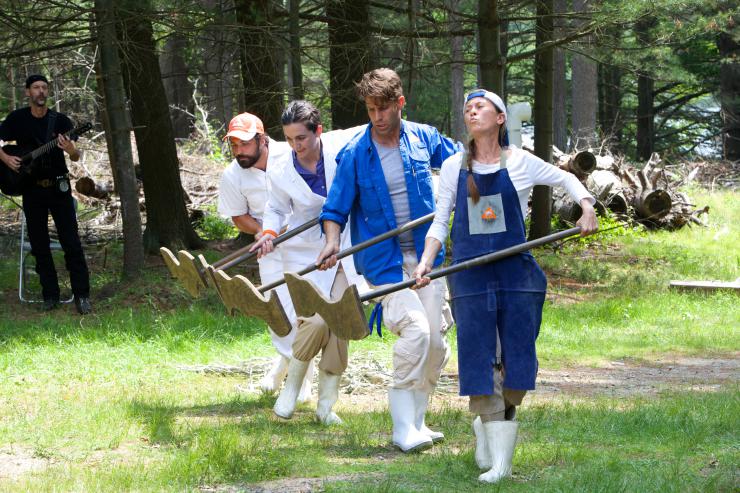
The most important ingredient in Cry You One, however, is music. The company sings, dances, and plays instruments along with two talented musicians (Ms. Randels and Sean LaRocca). The Cajun rhythms and hypnotic melodies make the genius loci of southern Louisiana palpable. One of the performers says, “you can know this about any place / some one loved it / someone lost it.” The music carries the beauty and heartbreak of this axiom, and connects the participants of Cry You One with their best scene partner—the land itself. As we move through the landscape, we follow the rhythm with our feet, caressing the ground as if it were a lover.
In our contemporary world of mediated and isolated interaction, the production offers its audience the rare but vital chance to practice collective creation in the face of imminent destruction.
Like the terrain of Maltby Lakes, however, the dramaturgy of Cry You One can be difficult to navigate. The event contains two main through-lines. One through-line dramatizes the M.O.S.Q.U.I.T.O. activists and their “eco-tour.” The organization derives its name from the proverb, “If you think you're too small to make a difference, try spending a night in a tent with a mosquito.” But they seem to have as many issues with each other as they do with big oil and gas. Infighting and bickering disrupt their group discussions. The second through-line of Cry You One is a ritual devoted to a disappearing land and way of life. Encapsulated by the Gregorian-chant-like refrain, “sinking, sinking / waves in, waves out,” this is the world of the Snake dance, the music of the Bone Gang, animal masks, and tales filled with fantastic creatures and folklore.
Cry You One intricately weaves these two strands together in a way that makes interpreting the final tapestry of art and activism intriguing to behold but difficult to unravel. For example, after the company disappears for a bit, they return in different costumes. The solid blues and whites of the M.O.S.Q.U.I.T.O. logo have been replaced by pastel, pantone jumpsuits and matching animal masks. Who are these animal-spirit avatars? What is their relationship to M.O.S.Q.U.I.T.O.? Is this part of the eco-tour or a detour? Mysteriously, the group’s squabbling, a major element in the opening, vanishes halfway through the show. It signals a change but its precise nature remains murky.
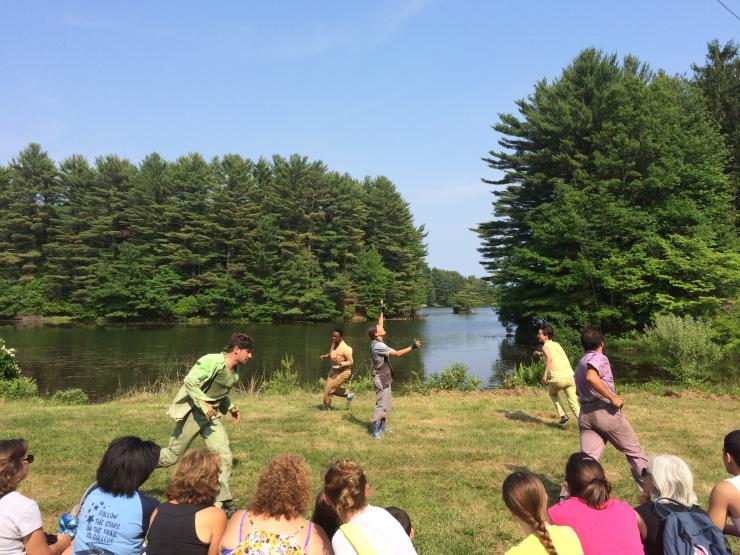
What’s clear throughout the play is that pollutants and noxious politics continue to destroy and terrorize coastal Louisiana and its denizens at an alarming rate. Since time is running out, the question is: what do we do? As citizens? As artists? In this case, perhaps the medium is the message. Cry You One brings together science and the spirit. The production suggests that pollution pertains as much to the soul and it does to the ecosystem, and it’s telling that one of the performers refers to slavery as a “spiritual cancer.” On the flipside, the final moments of the show endorse the belief that healing involves stopping both industrial pollution and poisonous states of mind. In Cry You One, art and politics nourish one another in a symbiotic relationship—an antidote to sinking shores and spirits alike. One of the M.O.S.Q.U.I.T.O. activists tells the audience, “All successful social movements involve music,” and their case is compelling. This tremendous set of problems called ecological-terrorism will require scientists, politicians, business people, spiritual leaders, and, yes, even artists.
But are we already too late? As I walked away from the performance, I surveyed all the cars pulling away from Maltby Lakes and into the street. How many of them run on gas from companies who pollute the Mississippi River? Just moments ago, we had all lifted up an altar symbolizing the skills and strength we had to create change. A part of me felt that the hope of that altar had just all gone up in smoke. I wondered if the show’s creators had let its audience off the hook. Aren’t all of us oil-dependent Americans just as much a part of the problem as the faceless corporate interests that M.O.S.Q.U.I.T.O. warned me about? Perhaps it is too early to tell. There is still time for things to change.
When Marx wrote, quoting Shakespeare, “All that is solid melts into air,” he dreamed of a new era arising out of a great struggle. At its best, Cry You One brings to life such a dream—a vision that is both catastrophic and catalytic. In our contemporary world of mediated and isolated interaction, the production offers its audience the rare but vital chance to practice collective creation in the face of imminent destruction.




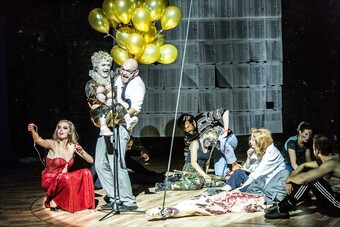

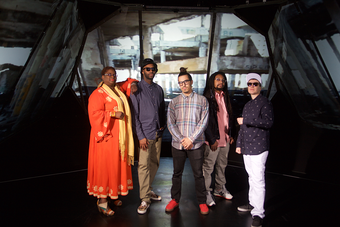

Comments
The article is just the start of the conversation—we want to know what you think about this subject, too! HowlRound is a space for knowledge-sharing, and we welcome spirited, thoughtful, and on-topic dialogue. Find our full comments policy here